A Guide to Surface Preparation
Section 1: Why Surface Preparation is Important
A coat of paint is a film engineered to protect a substrate and provide an aesthetic finish. Its ability to last depends entirely on adhesion.
Paint Adhesion and Film Formation
Paint adhesion is the result of molecular forces between the paint and the substrate. 1 This can be either mechanical or chemical. Mechanical adhesion occurs when liquid paint seeps into the microscopic pores of a surface and hardens. Chemical adhesion involves molecular bonds forming between the paint's polymers and the substrate. 1 A successful paint job maximizes both types of adhesion.
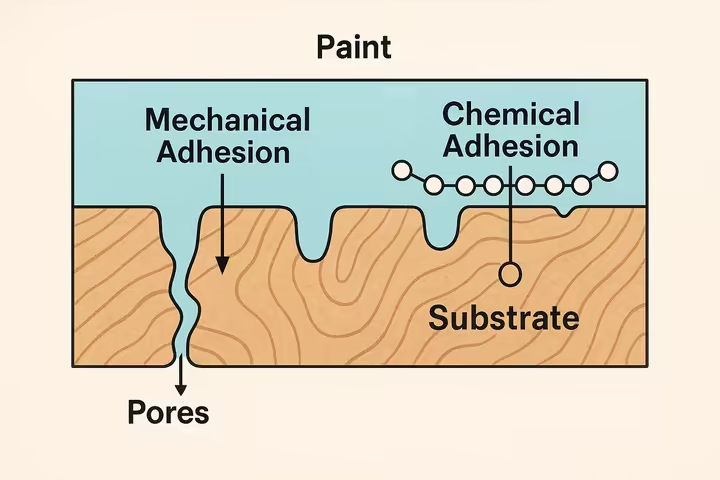
Surface Energy
Every surface has an energy level that determines how well a liquid can spread across it. Materials with high surface energy, like bare wood or metal, allow paint to spread out and form strong bonds. Materials with low surface energy, such as plastics or glossy paints, cause liquids to bead up. 1 Surface preparation involves cleaning and abrading surfaces to increase their energy, making them more receptive to a new coating.
The Role of Polymers and Film Formation
Primers and paints contain polymers—long, chain-like molecules that link together as the coating dries or "cures." 3 This process, called film formation, creates a continuous, flexible shield that resists cracking by expanding and contracting with the substrate. 2 The optimal total thickness for a dry paint system (one primer coat, two topcoats) is between 3.5 and 5 mils (thousandths of an inch). A film in this range provides robust protection without becoming too thick and brittle. 2
Environmental Stressors
Exterior paint is constantly exposed to UV radiation from sunlight, moisture, and heat. 2 These elements break down the paint's resin (the binder). As the resin degrades, pigment particles are released, leading to "chalking," fading, and eventual film failure. 4 A quality paint system applied over a properly prepared substrate is engineered to withstand these stressors.
Common Paint Failures
Most paint failures are caused by poor surface preparation.
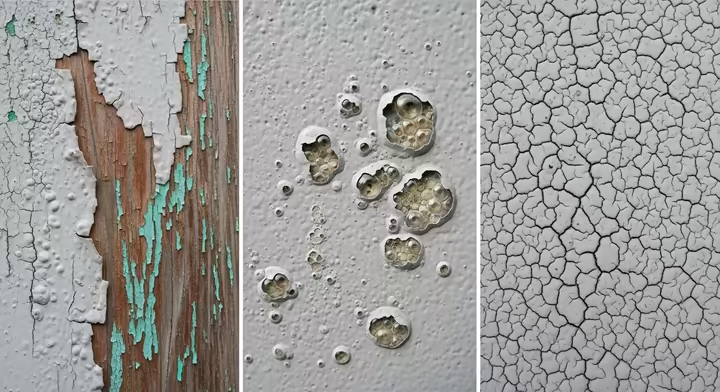
- Peeling and Flaking: A direct symptom of adhesion failure. The paint lifts because it never formed a proper bond. Common causes include painting over a dirty, damp, or glossy surface. 5 The most common cause is moisture getting behind the paint film, breaking the bond and pushing the paint off. 6
- Blistering: Bubbles caused by trapped moisture or gas trying to escape. 5 If blisters go down to the bare substrate, it indicates moisture migrating from within the wall (e.g., a leak or high humidity). 6 Blisters can also form when painting in direct, hot sunlight, which causes the surface to dry too quickly and trap solvents underneath. 5
- Alligatoring: This cracking pattern occurs when a hard, rigid coating is applied over a softer, more flexible one. 5 As the substrate expands and contracts, the brittle topcoat fractures. It can also be caused by applying a topcoat before the primer has fully cured. 10
- Checking and Cracking: Fine hairline cracks that can lead to flaking. This is often caused by applying paint too thinly or can be a sign of old, brittle oil-based paint. 5
Surface Analysis
A professional diagnoses a surface to determine the correct preparation.
Moisture Detection
Detecting moisture is a critical first step because it's a primary cause of paint failure. A surface can feel dry but still have too much moisture for paint to adhere properly. 7
-
Tools:
Two main types of moisture meters are used.
- Pin-Type Meters: Use two small pins that penetrate the surface to measure electrical resistance. They provide a precise moisture content percentage for materials like wood and drywall but leave small holes. 7
- Pinless Meters: Use electromagnetic waves to scan for moisture below the surface without causing damage. They are ideal for checking behind finished surfaces or assessing large areas quickly. 7
Adhesion Testing
Verify the adhesion of existing paint before applying a new coat. If the old paint is not well-adhered, the new paint will fail along with it.
- Tape Test: Firmly press a piece of sticky tape (like duct tape) onto the existing paint, then pull it off. If any flakes come off with the tape, the existing coating is unstable and must be scraped and sanded before priming. 14
- ASTM D3359 Cross-Hatch Test: The professional standard for quantitative assessment. 15 Use a utility knife to make a grid of cuts through the paint film to the substrate. Apply specified pressure-sensitive tape over the grid and pull it off rapidly. Adhesion is rated on a scale from 5B (no paint removed) to 0B (over 65% removed). Any result less than 5B indicates a potential adhesion problem. 17
Surface Porosity Assessment
Porous surfaces like new drywall, bare wood, and brick absorb paint unevenly if not sealed. This results in a blotchy finish and requires more paint for coverage. 2
- Water Drop Test: Place a few drops of water on the surface. If the water soaks in quickly, the surface is highly porous and requires a sealing primer. If the water beads up, the surface is non-porous and will likely need scuff-sanding to create a mechanical profile for the new paint to grip.
Section 2: Basic Preparation Steps
After assessing the surface, follow these preparation steps.
Cleaning Surfaces
Surfaces must be cleaned of grease, oil, and grime, as paint cannot bond to contaminants. 1
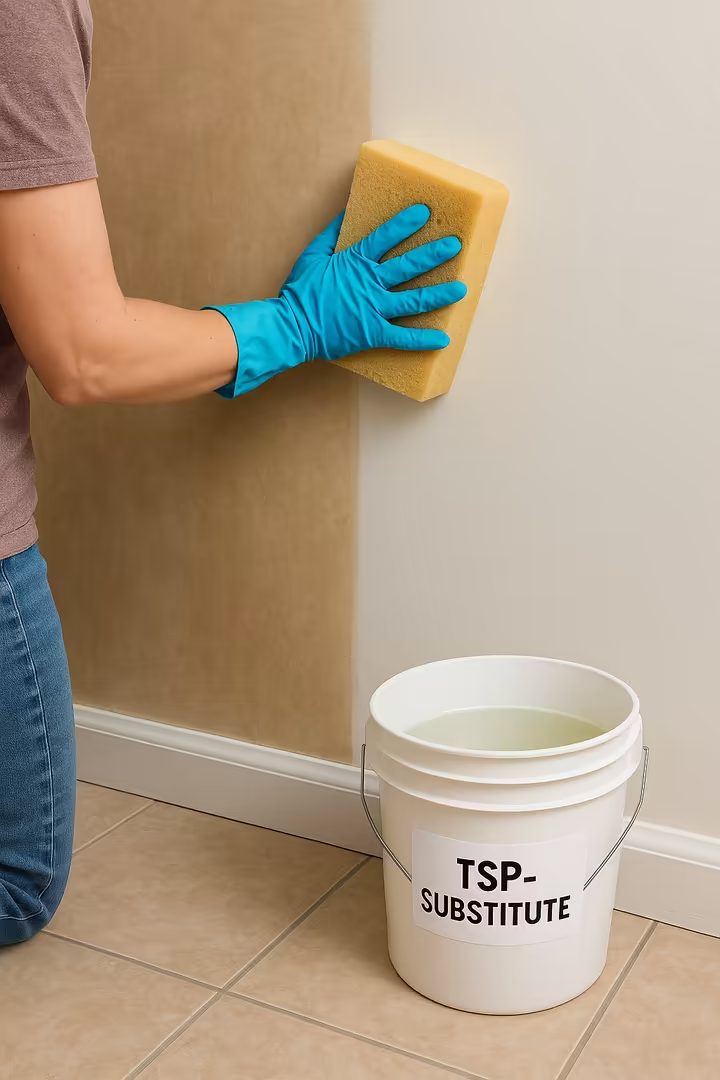
Trisodium Phosphate (TSP) vs. TSP-Substitutes
- Trisodium Phosphate (TSP): A powerful cleaner effective on heavy grease and grime. Its alkalinity also lightly etches surfaces, improving adhesion. 22 However, it is a skin and eye irritant requiring PPE and is an environmental pollutant banned in many areas. 22, 23 Any surface cleaned with TSP must be thoroughly rinsed with clean water , as leftover residue will cause paint adhesion to fail. 22
- TSP-Substitutes: Phosphate-free, biodegradable, and safer alternatives. 23 Many are "no-rinse," which saves labor. While not as potent as true TSP, they are sufficient for typical residential walls and are the preferred choice for most situations. 26
For standard walls, use a TSP-substitute. For heavily soiled areas, TSP may be required, but it must be used with full PPE and followed by meticulous rinsing.
Filling Imperfections
Fill holes, cracks, and dents to create a smooth surface. Use the correct filler for the repair.
- Spackle: Use for small, cosmetic repairs like nail holes and minor cracks in drywall or plaster. 27 It is typically made of gypsum powder and binders, dries quickly, and has low-shrinkage properties. 27, 29
- Joint Compound (Drywall Mud): Use for large-scale drywall work , such as taping seams or skim-coating a wall. 28 It has a longer drying time and will shrink more than spackle, requiring multiple thin coats, but it sands to a smoother, more durable finish. 29
- Epoxy Fillers: A two-part, structural filler used for repairing rotted or damaged wood, or for filling holes in materials like metal or concrete where high strength is needed.
Use spackle for small holes, joint compound for large drywall repairs, and epoxy for structural repairs, especially on wood.
Sanding
The purpose of sanding is not to remove old paint, but to smooth imperfections and de-gloss existing coatings to create a "mechanical tooth" for the new paint to grip. 31
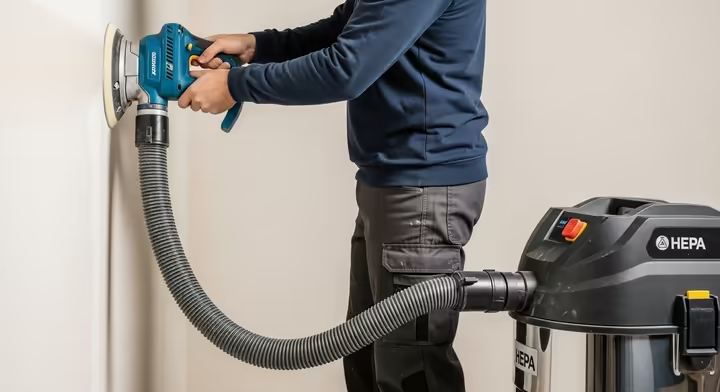
- Dust Control: Sanding produces fine dust that is a respiratory irritant. Wear a NIOSH-approved N95 mask at a minimum. 33 For large jobs, use a sander connected to a High-Efficiency Particulate Air (HEPA) vacuum to capture dust at the source. This protects air quality and health. 34
Table 1: Sandpaper Grit Selection Guide
| Task | Grit Range | Purpose and Use Case |
|---|---|---|
| Heavy Stripping / Shaping | 40–80 | Aggressive removal of failing paint or rust. Shaping raw wood. Can damage the substrate. 32 |
| General Smoothing & De-glossing | 100–150 | Scuffs existing paint to create tooth, smooths bare wood, initial sanding of drywall patches. 38 |
| Fine Smoothing | 180–220 | Final sanding pass before priming. Lightly sand between coats for a smooth finish. 31 |
| Ultra-Fine Finish | 240+ | Polishing the final topcoat, especially with high-gloss paints. 31 |
Priming
Primer is a specialized coating that solves surface problems and helps the topcoat adhere. It bonds to the substrate and provides a uniform surface for the finish paint. 3
The Three Chemistries of Primer
- Oil-Based (Alkyd) Primer: Best for exterior wood. It seals porous wood and blocks stains from water, nicotine, and tannin bleed from woods like cedar. 42 It has slow dry times, strong odors (high VOCs), and requires mineral spirits for cleanup. 41
- Latex-Based (Acrylic/Water-Based) Primer: Most common for general interior use, especially on new drywall. 42 It is flexible, fast-drying, low-odor, low-VOC, and cleans up with water. 45 It is not effective against heavy stains or tannin bleed. 45
- Shellac-Based Primer: The best choice for severe stains and odors (smoke, water damage, rust). 42 It dries very quickly and adheres to almost any surface. It is brittle, has strong fumes, and requires denatured alcohol for cleanup. 41
The Four Functions of Primer
- Sealing Primers: For porous surfaces like bare wood or new drywall. They prevent the topcoat from being absorbed unevenly, ensuring a uniform finish. 47
- Stain-Blocking Primers: Create a barrier to prevent stains from bleeding through the finish coat. Oil-based and shellac-based are most effective. 49
- Adhesion-Promoting (Bonding) Primers: For non-porous, slick surfaces like glass, tile, or glossy paints. They contain resins that "bite" into difficult substrates. 52
- Vapor Barrier Primers: A specialized interior primer for the inside face of exterior walls. It has a low permeability rating (perm < 1.0), which reduces moisture transfer into the wall cavity, helping to prevent mold and rot. 56
Table 2: Primer Selection Matrix
| Substrate / Problem | Latex-Based Primer | Oil-Based Primer | Shellac-Based Primer | Specialty Primer |
|---|---|---|---|---|
| New Drywall / Plaster | ✔ (Primary) | Use a Sealing/PVA Primer 43 | ||
| Bare Wood (Pine, Fir) | ✔ | ✔ (Primary) | Use a Sealing Primer 42 | |
| Bare Wood (Cedar, Redwood) | ✔ (Primary) | ✔ | Use a Tannin-Blocking Primer 44 | |
| Previously Painted (Good Condition) | ✔ | ✔ | Scuff sand first | |
| Glossy, Slick Surfaces (Tile, Glass) | Use a Bonding/Adhesion-Promoting Primer 53 | |||
| Minor Stains (Crayon, Scuffs) | ✔ | ✔ (Primary) | Use a Stain-Blocking Primer 45 | |
| Heavy Stains (Water, Smoke) | ✔ | ✔ (Primary) | Use a Stain-Blocking Primer 46 | |
| Persistent Odors (Smoke, Pet) | ✔ (Primary) | Use an Odor-Blocking Primer 46 | ||
| Masonry (Brick, Concrete) | ✔ (Primary) | Use a Masonry Sealer/Primer 43 | ||
| Interior of Exterior Walls | Use a Vapor Barrier Primer 56 |
Section 3: Hazard Assessment: Lead, Asbestos, and Mold
Preparing surfaces in older homes requires assessing them for lead, asbestos, and mold. Disturbing these materials can cause severe health risks. This section provides safety information based on U.S. government guidelines.
Lead Paint Safety
Homes built before 1978 are presumed to contain lead-based paint until proven otherwise. 60
Health Risks of Lead
Lead is a neurotoxin that is especially dangerous to children under six. 62 There is no known safe level of lead exposure . 63 Even low levels can cause irreversible harm, including developmental delays and reduced IQ. 62 In adults, it can cause high blood pressure and other health problems. 62 The primary danger during renovation is inhaling or ingesting microscopic lead dust created by sanding, scraping, or cutting. 62
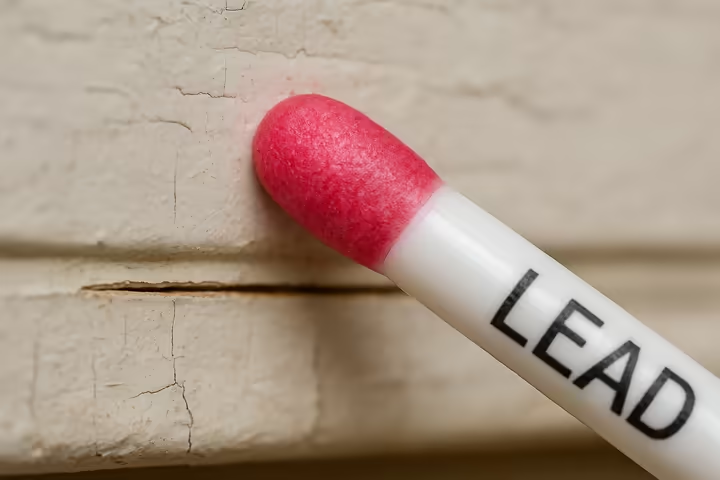
EPA Renovation, Repair, and Painting (RRP) Rule
- Who It Applies To: Contractors, painters, and property managers who perform renovation projects for compensation in pre-1978 housing or child-occupied facilities. 61
- Core Requirements: Firms must be an EPA Lead-Safe Certified Firm , and the work must be supervised by a Certified Renovator trained in lead-safe work practices. 60
- DIYer Responsibility: The RRP Rule does not typically apply to homeowners working on their own residence, unless they rent the property or operate a home-based daycare. 60 However, because the health risks are the same, the EPA strongly recommends that DIYers follow lead-safe practices to protect their families. 67
What to Do If Lead is Present
A Certified Renovator can use an EPA-recognized test kit to check for lead. 68 A color change to pink or red indicates lead is present. 69 If lead paint is present, or assumed to be present, non-certified individuals must STOP WORK . Hire an EPA Lead-Safe Certified firm to perform the renovation.
Asbestos Safety
Asbestos is a mineral fiber used in building materials from the 1940s through the 1970s. 71 It can be found in insulation, "popcorn" ceilings, textured paints, vinyl flooring, siding, and joint compounds in homes built before the 1980s. 72
Friable vs. Non-Friable Asbestos
The risk from asbestos depends on whether its fibers can become airborne.
- Friable Asbestos: Material that can be crumbled by hand pressure when dry (e.g., old pipe insulation, popcorn ceilings). 73 It is extremely dangerous because fibers can be released with the slightest disturbance. 75
- Non-Friable Asbestos: Fibers are tightly bound in a solid material (e.g., vinyl floor tiles, cement siding). 73 It is not a hazard when intact, but becomes dangerous if sanded, sawed, or broken. 78
Health Risks and Safe Approach
There is no safe level of asbestos exposure. 79 When inhaled, fibers lodge in the lungs and can lead to fatal diseases like asbestosis and mesothelioma decades later. 79
- Test for Asbestos: You cannot identify asbestos visually. Suspected material must be sampled by a trained professional and analyzed by a lab. 77 Never sample it yourself.
- When to Leave or Encapsulate: If material contains asbestos but is in good, non-friable condition and will not be disturbed, the safest action is to leave it alone. 72 The second option is encapsulation (sealing the material with a special coating). Painting over an intact popcorn ceiling is a common form of encapsulation. 84
- Professional Abatement Required: If an asbestos-containing material is damaged or must be removed, this work must be performed by a licensed asbestos abatement contractor. This is never a DIY project. 82
Mold and Mildew
Mold or mildew on a surface indicates an excess moisture problem. Mildew is a type of mold that is often powdery and white or gray. Other molds can be fuzzy or slimy and appear in various colors. 88, 90
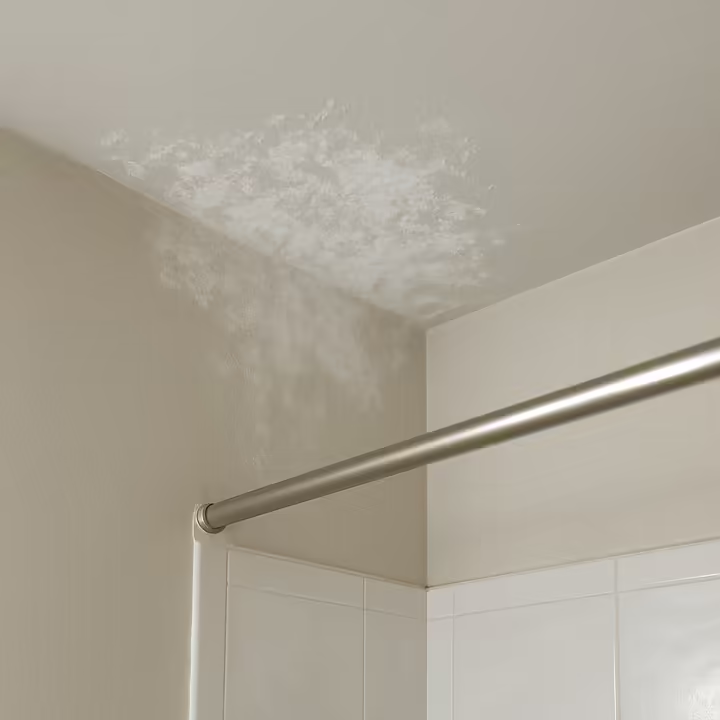
Moisture Control
Mold spores are always present and grow on damp surfaces. To control mold, you must control moisture. 92 Cleaning or painting over mold without fixing the moisture source (e.g., a leak, poor ventilation) is ineffective, as the mold will return. 92
EPA Guidelines: When to DIY vs. When to Call a Professional
- DIY Scale (Less than 10 square feet): If the moldy area is less than 10 sq. ft., cleanup is often manageable. 93 Fix the moisture problem, scrub the mold off hard surfaces with detergent and water, and dry the area completely. Porous materials like moldy carpet should be discarded. 94
- Professional Remediation (More than 10 square feet): If the moldy area is larger than 10 sq. ft., is in the HVAC system, or was caused by contaminated water, professional remediation is required. 94
Section 4: Workflow and Safety
This section outlines a workflow for surface preparation, including safety, containment, and environmental controls.
Personal Protective Equipment (PPE)
Use Personal Protective Equipment (PPE) appropriate for the task's potential hazards. 100
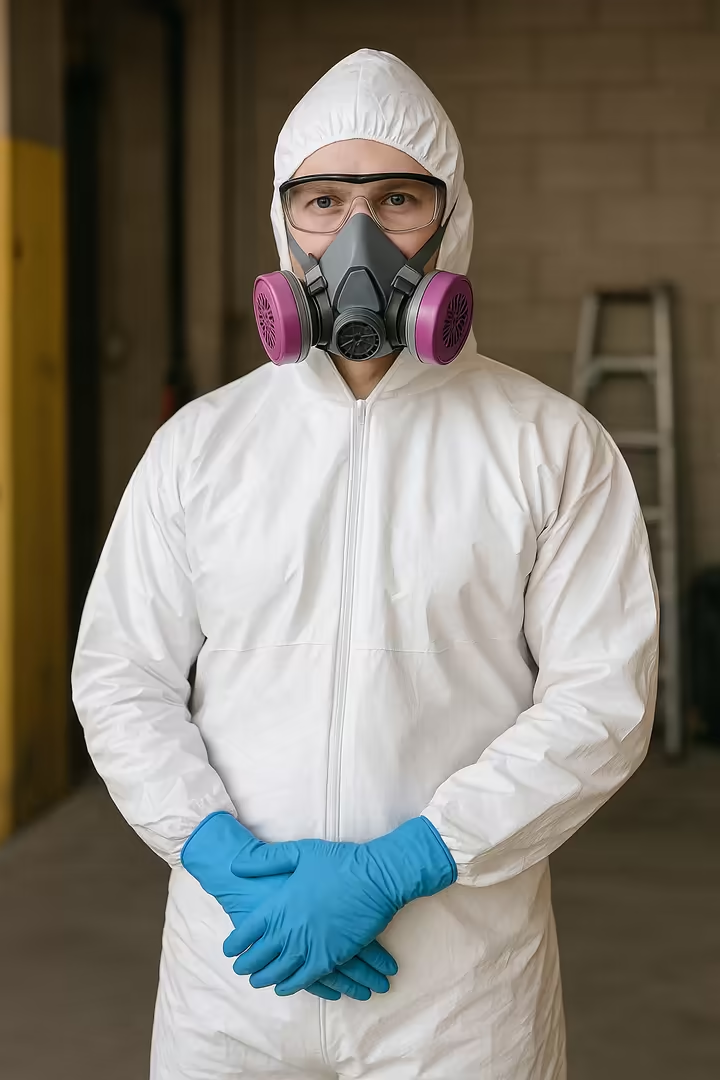
-
Respiratory Protection:
- N95 Respirator: Filters 95% of airborne particulates . Suitable for sanding modern drywall or wood. Not effective against chemical vapors or lead/asbestos fibers. 33
- P100 Respirator/Cartridge: Filters 99.97% of airborne particulates and is oil-resistant. A P100 cartridge in a reusable respirator is the minimum protection required by OSHA for work involving lead, asbestos, or significant mold. 33
- Eye Protection: Non-vented goggles offer protection from chemical splashes and hazardous dust like lead. A face shield over goggles provides full-face protection when using a paint sprayer. 33, 102
- Hand Protection: Nitrile gloves work for general painting. Use heavy-duty, chemical-resistant gloves for harsh solvents. 103
- Body Protection: For projects with lead, asbestos, or mold, wear disposable coveralls and shoe covers to prevent contaminating clothing and other areas. 102
Table 3: PPE Selection Guide for Painting & Prep Tasks
| Task | Respirator Type | Eye Protection | Gloves | Body Covering |
|---|---|---|---|---|
| Interior Painting (Latex, Brush/Roll) | Recommended | Safety Glasses | Nitrile | Work Clothes |
| Sanding Non-Hazardous Surfaces | N95 (Minimum) | Vented Goggles | Work Gloves | Work Clothes |
| Spraying Oil-Based or Solvent Paints | P100 Half-Mask | Goggles + Face Shield | Chemical-Resistant | Coveralls |
| Mold Cleanup (<10 sq ft) | N95 (Minimum) | Non-Vented Goggles | Nitrile or Rubber | Work Clothes |
| Lead Paint Disturbance (RRP Work) | P100 Half-Mask (Minimum) | Non-Vented Goggles | Nitrile | Disposable Coveralls |
| Asbestos Handling (Professional Only) | P100 Full-Face | Full-Face Respirator | Nitrile | Disposable Coveralls |
Work Zone Containment
Containment isolates the work area to prevent dust and contaminants from spreading. This is important for cleanliness and essential for health and safety when dealing with hazardous materials. 104

- Empty the Room: Remove furniture and household items. Wrap items that cannot be moved in 6-mil plastic sheeting, sealed with tape. 104
- Seal Surfaces: Cover the entire floor with plastic sheeting, running it up the baseboards and taping it securely.
- Isolate Area: Seal gaps around doors and windows. Shut down the home's HVAC system and seal all supply and return vents in the work area. 104
- Establish Entry/Exit: Use a commercial zip-wall system (a plastic barrier with a zipper) for entry to maintain the seal. 104
- Create Negative Air Pressure (for hazardous dust): For lead, asbestos, or heavy mold work, place a HEPA-filtered air scrubber in a window, blowing air out . Seal the rest of the window. This creates a vacuum, ensuring contaminated air does not flow out of the work area. 104
Waste Disposal
Follow federal, state, and local regulations for waste disposal. Do not put hazardous renovation waste in household trash.
- Non-Hazardous Debris: General construction debris like clean wood or modern drywall can typically go to a designated C&D landfill. 107
-
Hazardous Waste (Lead and Asbestos):
This waste requires strict handling.
- Materials containing lead or asbestos are prohibited from municipal landfills. 110
- Waste must be wetted down, placed in 6-mil plastic bags, "gooseneck" sealed (twist, fold, tape), double-bagged, and labeled as hazardous waste. 74
- Local Regulations are Paramount: Disposal rules are highly localized. Contact your local municipal waste authority or state environmental agency for specific requirements for legal disposal. Waste may need to be transported by a licensed hauler to a permitted landfill. 112, 114
Weather Conditions
For exterior projects, weather conditions dictate the work schedule and affect the paint's final quality.
- Temperature: Most latex paints require a surface temperature between 50°F and 85°F (10°C to 29°C). 116 If it's too hot, paint can "flash dry," causing poor adhesion and blisters. If it's too cold, the paint film becomes weak and brittle. 118
- Humidity: High humidity (above 70-80%) dramatically slows drying time, which can cause paint to sag or run. 119 It can also cause surfactant leaching, leaving sticky or discolored streaks. The ideal range is 40-50% humidity. 5
- Wind and Rain: Wind accelerates drying and can blow debris onto wet paint. 116 Ensure there is a clear, dry window of at least 24 to 48 hours after application for the paint to cure. 119
Conclusion
Proper surface preparation is the foundation of a durable, high-quality paint finish. It requires an understanding of adhesion, material compatibility, and environmental factors.
While many preparation tasks are within the capability of a skilled person, the most critical skill is knowing when to stop. If you find lead paint, friable asbestos, or significant mold, do not proceed. The only responsible action is to hire certified professionals trained to handle these hazards safely and legally. This decision protects the health of everyone involved.
Works cited
- The Science of Paint Adhesion: How It Works - SISU Painting, https://sisupainting.com/the-science-of-paint-adhesion-how-it-works/
- Painting - Building Science, https://buildingscience.com/sites/default/files/migrate/pdf/RR-0409_Painting.pdf
- The Science Behind Paint Adhesion: How Primers Work, https://ebpainting.ca/the-science-behind-paint-adhesion-how-primers-work/
- RR-0409: Painting | buildingscience.com, https://buildingscience.com/documents/reports/rr-0409-painting/view
- Davis Paint Problem Solver - The Davis Paint Company, https://www.davispaint.com/DavisPaintProblemSolver.aspx
- Common Paint Problems | Scholars Edge, https://scholarsedge.biz/common-paint-problems/
- Moisture Content and Painting - Klappenberger & Son, https://klappenbergerandson.com/painting-moisture-content/
- Understanding Common Paint Failures - Fayetteville Experts - CertaPro Painters, https://certapro.com/fayetteville/understanding-paint-failures/
- Common Exterior Paint Problems And How To Fix Them, https://www.hellopainting.co/post/common-exterior-paint-problems-and-how-to-fix-them
- Alligatoring Paint: Understanding, Causes & Solutions, https://blankcanvaspainting.com/alligatoring-paint-understanding-causes-solutions/
- What caused my paint to alligator and how to fix it? - Home Improvement Stack Exchange, https://diy.stackexchange.com/questions/182320/what-caused-my-paint-to-alligator-and-how-to-fix-it
- How to Use a Moisture Meter to Notice and Prevent Water Damage - This Old House, https://www.thisoldhouse.com/smart-homes/94988/how-to-use-a-moisture-meter-2
- Testing for Moisture in Walls for Home Inspections Damage-Free, https://blog.protimeter.com/blog/testing-for-moisture-in-walls-damage-free
- How to test or check paint adhesion - GP&D Restoration - Denver House Painting Pro, https://denverhousepaintingpro.com/how-to-test-or-check-paint-adhesion/
- Test Methods for Coating Adhesion | Resources | DeFelsko, https://www.defelsko.com/resources/test-methods-for-coating-adhesion
- ASTM Paint Adhesion Testing - Applied Technical Services, https://atslab.com/standard/american-society-for-testing-and-materials/astm-paint-adhesion-testing/
- Basics of Conducting Adhesion Testing | Sika USA, https://usa.sika.com/dam/dms/us01/a/us-lahabra-tech-bulletin-basics-of-conducting-adhesion-testing.pdf
- How to Test Coating Adhesion - YouTube, https://www.youtube.com/watch?v=XXVqiZeo4mI
- Porosity Testing - Gurley, Sheffield, Bendtsen - Industrial Physics, https://industrialphysics.com/knowledgebase/articles/porosity-testing-gurley-sheffield-bendtsen/
- How is paint porosity measured? Q&A - NBchao.Com, https://en1.nbchao.com/w/3779/
- Porosity Testing - TCA Lab / Alfa Chemistry, https://tcalab.alfa-chemistry.com/material-testing/porosity-testing.html
- Powder TSP or liquid TSP substitute? : r/paint - Reddit, https://www.reddit.com/r/paint/comments/1aka30r/powder_tsp_or_liquid_tsp_substitute/
- Are TSP Substitutes as Good as the Real Thing? | Family Handyman, https://www.familyhandyman.com/article/trisodium-phosphate-substitutes/
- What are the differences among "TSP" cleaners? - Home Improvement Stack Exchange, https://diy.stackexchange.com/questions/153906/what-are-the-differences-among-tsp-cleaners
- Learn More about Klean Strip® TSP Substitute, https://kleanstrip.com/tutorials/learn-more-about-klean-strip-tsp-substitute/
- Your favourite NO-RINSE pre-paint cleaner? No TSP or dish soap allowed! - Reddit, https://www.reddit.com/r/paint/comments/1jei36w/your_favourite_norinse_prepaint_cleaner_no_tsp_or/
- Spackling 101 | DAP Global, https://www.dap.com/resources-support/how-to-s-tips/wall-repair/spackling-101/
- When to Use Spackle vs Joint Compound | HGTV, https://www.hgtv.com/how-to/home-improvement/what-is-the-difference-between-spackle-and-joint-compound
- Joint Compound vs. Spackle: When to Use Each - The Spruce, https://www.thespruce.com/joint-compound-vs-spackle-5180404
- Joint Compound vs. Spackle: When to Use Each One | Angi, https://www.angi.com/articles/joint-compound-vs-spackle.htm
- How to Choose the Right Sandpaper for Your Painting Project - TRICO PAINTING, https://tricopainting.com/trico-painting-blog/how-to-choose-the-right-sandpaper-for-your-painting-project/
- How To Choose and Use Sandpaper - This Old House, https://www.thisoldhouse.com/tools/21016261/how-to-choose-and-use-sandpaper
- Essential Painting PPE: A Guide to Staying Safe - ServiceTitan, https://www.servicetitan.com/blog/painting-ppe
- Drywall Dust Control and Containment | Sanding | Walltoolc.com - Wall Tools, https://walltools.com/drywall-dust-control-containment/
- Putting Drywall Sanders to the Test: Power, Precision, and Dust Control - YouTube, https://www.youtube.com/watch?v=faa66qSnzNE&vl=en
- Ultimate Dustless Drywall Sanding System for Sale | Pro Wood Finishes, https://prowoodfinishes.com/product/equipment/sanders-dust-extraction/sanding-systems/other-sanding-systems/ultimate-dustless-drywall-sanding-system/
- Drywall Vacuums - All-Wall Equipment, https://www.all-wall.com/tools-by-category/sanding-tools/drywall-vacuums
- How To Choose The Right Sandpaper | Benjamin Moore, https://www.benjaminmoore.com/en-us/interior-exterior-paints-stains/how-to-advice/painting-101/how-to-choose-right-sandpaper
- How to Choose Sandpaper Grit - The Spruce, https://www.thespruce.com/choose-the-right-sandpaper-grit-1822681
- tricopainting.com, https://tricopainting.com/trico-painting-blog/how-to-choose-the-right-sandpaper-for-your-painting-project/#:~:text=Types%20of%20Sandpaper&text=Fine%20(150%2D180%20grit)%3A,finish%20on%20the%20final%20coat.
- Types of Paint Primer - Hillis Brothers Painting, https://www.hillisbrothers.com/post/types-of-paint-primer
- Choose the Right Primer: Oil, Latex or Shellac - True Value Hardware, https://www.truevalue.com/diy-projects/paint-and-stain/choose-the-right-primer/
- Primer Buying Guide - Lowe's, https://www.lowes.com/n/buying-guide/primer-buying-guide
- Covering knots and tannin in wood : r/paint - Reddit, https://www.reddit.com/r/paint/comments/w3riom/covering_knots_and_tannin_in_wood/
- Choose the Right Primer: Oil, Latex or Shellac - True Value Hardware, https://www.truevalue.com/diy-projects/paint-and-stain/choose-the-right-primer
- What primer do I need? Types of primers and their uses explained - The Paint Shed, https://www.thepaintshed.com/tips-advice/what-primer-do-i-need
- VersEseal Porous Primer - Superior Adhesion for Porous Surfaces, https://verseseal.com.au/product/verseseal-porous-primer/
- Primers That Seal Porous Surfaces - YouTube, https://www.youtube.com/playlist?list=PLcSEvV6MAygXtk2uaerJL5NIikWvXGgrj
- Stain Blocker Primer - Beautifully Reimagined, https://beautifullyreimagined.com/product-category/general-finishes/primer/
- Stain Blocking | Primers - Rust-Oleum, https://www.rustoleum.com/Primers/Stain-Blocking/all
- Kem Aqua® 5431 Tannin Blocking Primer - Sherwin-Williams Industrial Coatings, https://industrial.sherwin-williams.com/na/us/en/industrial-wood/catalog/product/products-by-industry.11543394/kem-aqua-5431-tannin-blocking-primer.9749436.html
- Primers and Adhesion Promoters - MasterBond.com, https://www.masterbond.com/applications/primers-and-adhesion-promoters
- Zinsser 1 gal. Extreme Adhesion Interior/Exterior Primer 348829 - The Home Depot, https://www.homedepot.com/p/Zinsser-1-gal-Extreme-Adhesion-Interior-Exterior-Primer-348829/308286664
- Eastman Polyolefin Adhesion Promoters, Eastman - ChemPoint, https://www.chempoint.com/products/eastman/eastman-polyolefin-adhesion-promoters
- Adhesion Primers & Promoters | Surface Treatments | CAPLINQ Corporation, https://www.caplinq.com/adhesion-primers-promoters.html
- Vapor Shield Primer - Rodda Paint, https://www.roddapaint.com/product/interior-primer/vapor-shield-primer/
- SEAL GRIP Perm Sealer/Vapor Barrier - PPG Paints, https://www.ppgpaints.com/products/interior-paint/seal-grip-perm-sealer-vapor-barrier
- Vapor Lok - millerpaint.com, https://www.millerpaint.com/product/vapor-lok-interior-primer/
- Interior Vapor Barrier Primer - Dutch Boy Paints, https://www.dutchboy.com/en/products/pro-paint/interior-vapor-barrier.html
- Lead Renovation, Repair and Painting Program | US EPA, https://www.epa.gov/lead/lead-renovation-repair-and-painting-program
- The EPA's Renovation, Repair and Painting (RRP) Rule FAQs - Home Improvement Commission - Maryland Department of Labor, https://labor.maryland.gov/license/mhic/mhicleadpaintfaqs.shtml
- Lead poisoning - Symptoms & causes - Mayo Clinic, https://www.mayoclinic.org/diseases-conditions/lead-poisoning/symptoms-causes/syc-20354717
- Blood Lead Levels in Children - Information from CDC | WIC Works Resource System, https://wicworks.fns.usda.gov/resources/blood-lead-levels-children-information-cdc
- Lead poisoning - World Health Organization (WHO), https://www.who.int/news-room/fact-sheets/detail/lead-poisoning-and-health
- Know the Facts | Childhood Lead Poisoning Prevention - CDC, https://www.cdc.gov/lead-prevention/communication-resources/know-the-facts.html
- EPA's RRP: RENOVATION, REPAIR & PAINTING RULE, https://www.epa.gov/system/files/documents/2022-05/ct-rrp-fact-sheet.pdf
- Lead-Safe Renovations for DIYers | US EPA, https://www.epa.gov/lead/lead-safe-renovations-diyers
- Lead Test Kits | US EPA, https://www.epa.gov/lead/lead-test-kits
- Lead Test Kits | Occupational Safety and Health Administration, https://www.osha.gov/lead/lead-test
- Able Safety Consulting - Using EPA Recognized Test Kits to Check For Lead-based Paint, https://www.youtube.com/watch?v=MJ-9StPxv28
- Asbestos in Building Materials | Placer County, CA, https://www.placerair.org/1598/Asbestos-in-Building-Materials
- Asbestos In The Home | CPSC.gov, https://www.cpsc.gov/safety-education/safety-guides/home/asbestos-home
- Asbestos Containing Material - Waste & Debris Fact Sheets | I-WASTE DST | US EPA, https://iwaste.epa.gov/guidance/natural-disaster/fact-sheets/types-of-waste?id=asbestos-containing-materials
- 1926.1101 App H - Substance Technical Information for Asbestos - Non-Mandatory | Occupational Safety and Health Administration, https://www.osha.gov/laws-regs/regulations/standardnumber/1926/1926.1101AppH
- What Is Friable Asbestos? | Risks from Non-Friable Material - Mesothelioma Hub, https://www.mesotheliomahub.com/mesothelioma/asbestos/how-to-identify-asbestos/friable-asbestos/
- Friable Definition in Construction in the USA, https://alsyedconstruction.com/friable-definition-in-construction-in-the-usa/
- Protect Your Family from Exposures to Asbestos | US EPA, https://www.epa.gov/asbestos/protect-your-family-exposures-asbestos
- Friable Vs. Non-Friable Asbestos - Goldberg, Persky & White, P.C., https://gpwlaw.com/news/friable-vs-non-friable-asbestos/
- Asbestos: Worker and Employer Guide to Hazards And Recommended Controls - National Institute of Environmental Health Sciences, https://www.niehs.nih.gov/sites/default/files/health/materials/asbestos_508.pdf
- Health Effects of Asbestos - Agency for Toxic Substances and Disease Registry - CDC, https://www.atsdr.cdc.gov/asbestos/health-effects/index.html
- Asbestos | ToxFAQs™ | ATSDR - CDC, https://wwwn.cdc.gov/TSP/ToxFAQs/ToxFAQsDetails.aspx?faqid=29&toxid=4
- Your Guide to Hiring an Asbestos Abatement Company, https://www.asbestos.com/abatement-guide/
- Guidelines for the Use of Encapsulants on Asbestos-Containing Materials, Draft - epa nepis, https://nepis.epa.gov/Exe/ZyPURL.cgi?Dockey=9100IIMR.TXT
- for the use of encapsulants - Fiberlock Technologies, https://www.fiberlock.com/wp-content/uploads/EPA-1981-Guidelines-for-the-Use-of-Encapsulants.pdf
- The Asbestos Abatement Process: What to Expect - RPF Environmental, https://www.airpf.com/the-asbestos-abatement-process-what-to-expect/
- Residential Lead & Asbestos Removal & Abatement Services - ATI Restoration, https://atirestoration.com/core-services/mold-environmental/lead-asbestos-abatement/
- Understanding the Process of Professional Asbestos Abatement - Intrepid Restoration, https://www.intrepidrestoration.com/understanding-the-process-of-professional-asbestos-abatement
- What is the difference between Mold and Mildew? | US EPA, https://www.epa.gov/mold/what-difference-between-mold-and-mildew
- How to Identify and Treat Mold vs. Mildew in Your Home - The Pioneer Woman, https://www.thepioneerwoman.com/home-lifestyle/a60686967/mildew-vs-mold/
- Mold and Mildew | Pacific Northwest Center for Translational Environmental Health Research | Oregon State University, https://ehsc.oregonstate.edu/resources/mold-and-mildew
- Is this mold or mildew? : r/CleaningTips - Reddit, https://www.reddit.com/r/CleaningTips/comments/1h7aoas/is_this_mold_or_mildew/
- What are the basic mold cleanup steps? | US EPA, https://www.epa.gov/mold/what-are-basic-mold-cleanup-steps
- A Brief Guide to Mold, Moisture, and Your Home EPA-402-K-02-003, September 2010, https://www.epa.gov/sites/default/files/2016-10/documents/moldguide12.pdf
- Mold Cleanup in Your Home | US EPA, https://www.epa.gov/mold/mold-cleanup-your-home
- EPA Mold Remediation Guidelines | SI Restoration In Baltimore / Washington DC explained, https://www.si-restoration.com/resources/mold-remediation/epa-mold-remediation-guidelines-si-restoration-baltimore-washington-dc
- Mold Removal: When to DIY the Job or Hire A Pro - Today's Homeowner, https://todayshomeowner.com/mold/guides/mold-removal-when-to-diy-the-job-or-hire-a-pro/
- When Is Mold Remediation Required | Angi, https://www.angi.com/articles/4-signs-you-need-mold-remediation.htm
- I See Mold. Do I Really Need a Mold Professional? - Moldman, https://www.moldmanusa.com/post/i-see-mold-do-i-really-need-a-mold-professional
- Who can test my home or clean, fix and remediate my home for mold? | US EPA, https://www.epa.gov/mold/who-can-test-my-home-or-clean-fix-and-remediate-my-home-mold
- Personal Protective Equipment - OSHA, https://www.osha.gov/sites/default/files/publications/osha3151.pdf
- OSHA Compliant PPE | Paint Finishing - C.H. Reed, https://www.chreed.com/paint-finishing-fluid-handling-aftermarket/personal-protective-equipment/
- PPE for Painting: A Comprehensive Guide - Trimaco, https://trimaco.com/blog/what-ppe-to-wear-when-painting-a-comprehensive-guide/
- Using the Right PPE for Painting Jobs | Construction Fasteners and Tools, https://cf-t.com/blog/proper-ppe-painting-jobs
- 4 Ways to Contain Dust During Demolition and Remodeling - wikiHow, https://www.wikihow.com/Contain-Dust-During-Demolition-and-Remodeling
- How to Build a Dust Containment System - Trimaco, https://trimaco.com/blog/build-a-dust-containment-system/
- My first dust barrier. Any critique/things to do better? : r/HomeImprovement - Reddit, https://www.reddit.com/r/HomeImprovement/comments/kcqu7w/my_first_dust_barrier_any_critiquethings_to_do/
- Fort Worth C&D Landfill | Disposal | Dump - Waste Connections, https://www.wasteconnections.com/fort-worth-c-and-d-landfill/
- Construction & Demolition Debris Management - NCTCOG, https://www.nctcog.org/envir/materials-management/source-reduction-recycling/construction-demolition-debris-management
- Commercial Waste & Recycling - the City of Fort Worth, https://www.fortworthtexas.gov/departments/environmental-services/solidwaste/commercial
- Special Waste Disposal - Texas Commission on Environmental ..., https://www.tceq.texas.gov/permitting/waste_permits/msw_permits/waste-types/msw_specialwaste.html
- Guidelines for the Classification and Coding of Industrial and Hazardous Wastes (RG-22) - Texas Commission on Environmental Quality, https://www.tceq.texas.gov/goto/rg-022
- Household Hazardous Waste Collection | Westover Hills, TX, https://www.westoverhills.us/garbage-collection/pages/household-hazardous-waste-collection
- Household Hazardous Waste - the City of Fort Worth, https://www.fortworthtexas.gov/departments/environmental-services/environmental-quality/hazardouswaste
- Hazardous Waste Disposal Services in Fort Worth, Texas, https://www.hazardouswasteexperts.com/locations/texas/fort-worth/
- Disposal of Nuisance or Abandoned Buildings: Compliance Resources, https://www.tceq.texas.gov/assistance/waste/disposal-of-nuisance-or-abandoned-buildings-compliance-resources
- When Not to Paint Outside: Key Times to Avoid Exterior Painting | JC ..., https://jclicht.com/blogs/our-blog/when-not-to-paint-outside
- How Weather Conditions Affect Exterior Painting, https://hilltoppainting.com/how-weather-conditions-affect-exterior-painting/
- Temperature Guide for Exterior Painting | Benjamin Moore, https://www.benjaminmoore.com/en-us/interior-exterior-paints-stains/how-to-advice/exteriors/temperature
- How Weather Affects Exterior Commercial Painting Projects, https://www.smithpropainting.com/blog/how-weather-affects-exterior-commercial-painting-projects
- How Weather Conditions Affect Exterior Painting Projects - ProPainters, https://thepropainter.com/how-weather-conditions-affect-exterior-painting-projects/